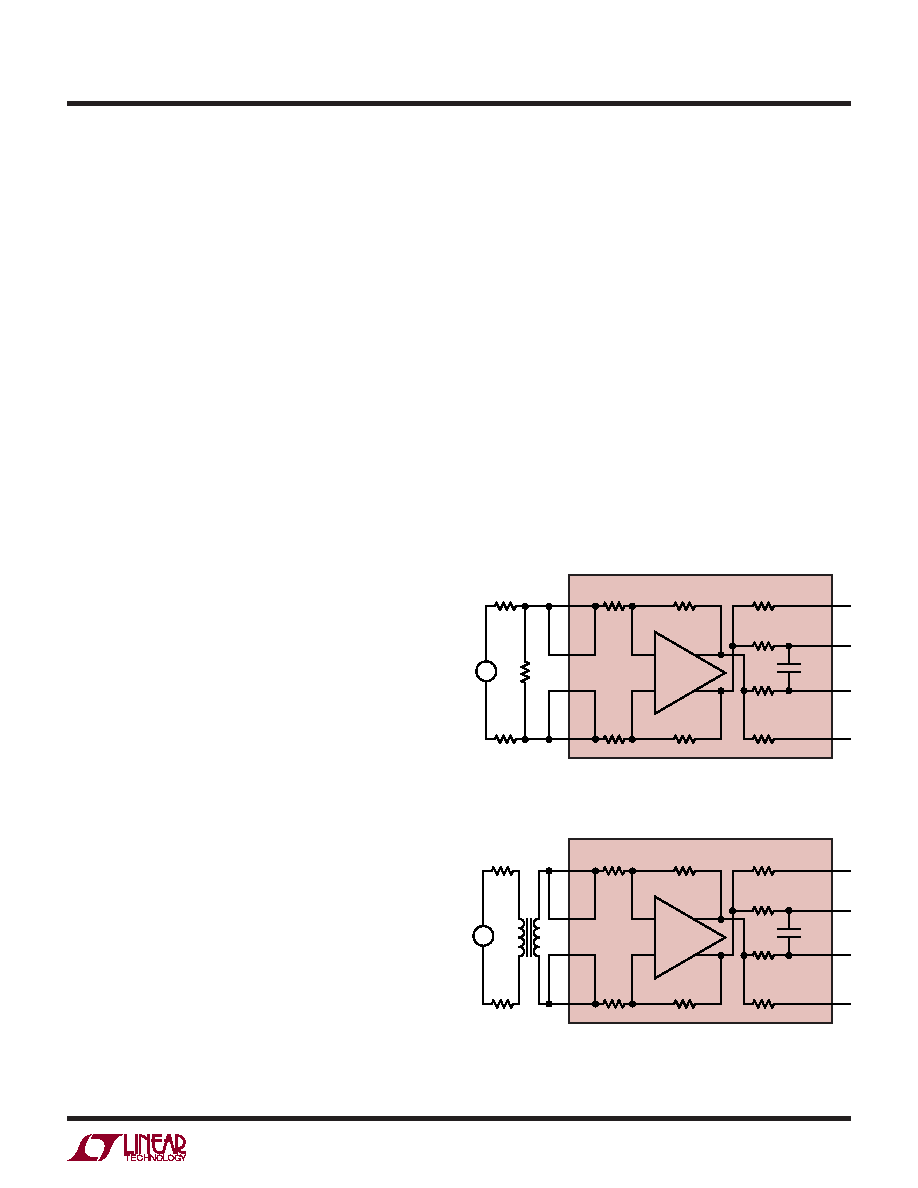- 您現(xiàn)在的位置:買賣IC網(wǎng) > PDF目錄8629 > LTC6400IUD-20#PBF (Linear Technology)IC ADC DRIVER DIFF 16-QFN PDF資料下載
參數(shù)資料
| 型號: | LTC6400IUD-20#PBF |
| 廠商: | Linear Technology |
| 文件頁數(shù): | 3/16頁 |
| 文件大小: | 0K |
| 描述: | IC ADC DRIVER DIFF 16-QFN |
| 標(biāo)準(zhǔn)包裝: | 121 |
| 類型: | ADC 驅(qū)動器 |
| 應(yīng)用: | 數(shù)據(jù)采集 |
| 安裝類型: | 表面貼裝 |
| 封裝/外殼: | 16-WFQFN 裸露焊盤 |
| 供應(yīng)商設(shè)備封裝: | 16-QFN-EP(3x3) |
| 包裝: | 管件 |
| 產(chǎn)品目錄頁面: | 1322 (CN2011-ZH PDF) |

LTC6400-20
11
640020f
APPLICATIONS INFORMATION
Circuit Operation
The LTC6400 is a low noise and low distortion fully dif-
ferential op amp/ADC driver with:
Operation from DC to 1.8GHz (–3dB bandwidth)
Fixed gain of 10V/V (20dB)
Differential input impedance 200Ω
Differential output impedance 25Ω
On-Chip 590MHz output lter
The LTC6400 is composed of a fully differential amplier
with on chip feedback and output common mode voltage
control circuitry. Differential gain and input impedance are
set by 100Ω/1000Ω resistors in the feedback network.
Small output resistors of 12.5Ω improve the circuit stability
over various load conditions. They also provide a possible
external ltering option, which is often desirable when the
load is an ADC.
Filter resistors of 50Ω are available for additional ltering.
Lowpass/bandpass lters are easily implemented with just
a couple of external components. Moreover, they offer
single-ended 50Ω matching in wideband applications and
no external resistor is needed.
The LTC6400-20 is very exible in terms of I/O coupling.
It can be AC- or DC-coupled at the inputs, the outputs or
both. Due to the internal connection between input and
output, users are advised to keep input common mode
voltage between 1V and 1.6V for proper operation. If the
inputs are AC-coupled, the input common mode voltage
is automatically biased close to VOCM and thus no external
circuitry is needed for bias. The LTC6400-20 provides an
output common mode voltage set by VOCM, which allows
driving an ADC directly without external components such
as a transformer or AC coupling capacitors. The input
signal can be either single-ended or differential with only
minor differences in distortion performance.
Input Impedance and Matching
The differential input impedance of the LTC6400-20 is
200Ω. If a 200Ω source impedance is unavailable, then
the differential inputs may need to be terminated to a lower
value impedance, e.g. 50Ω, in order to provide an imped-
ance match for the source. Several choices are available.
One approach is to use a differential shunt resistor (Figure
1). Another approach is to employ a wide band transformer
(Figure 2). Both methods provide a wide band impedance
match. The termination resistor or the transformer must
be placed close to the input pins in order to minimize
the reection due to input mismatch. Alternatively, one
could apply a narrowband impedance match at the inputs
of the LTC6400-20 for frequency selection and/or noise
reduction.
Referring to Figure 3, LTC6400-20 can be easily congured
for single-ended input and differential output without a
balun. The signal is fed to one of the inputs through a
matching network while the other input is connected to
the same matching network and a source resistor. Because
the return ratios of the two feedback paths are equal, the
two outputs have the same gain and thus symmetrical
Figure 1. Input Termination for Differential 50Ω Input Impedance
Using Shunt Resistor
Figure 2. Input Termination for Differential 50Ω Input Impedance
Using a 1:4 Balun
640020 F01
+OUT
+OUTF
–OUTF
–OUT
+IN
IN+
OUT–
IN–
OUT+
+IN
–IN
100
Ω
66.5
Ω
12.5
Ω
1000
Ω
LTC6400-20
100
Ω
25
Ω
25
Ω
VIN
1000
Ω
12.5
Ω
50
Ω
50
Ω
1.7pF
13
14
15
16
7
5
6
8
+
–
640020 F02
+OUT
+OUTF
–OUTF
–OUT
+IN
IN+
OUT–
IN–
OUT+
+IN
–IN
100
Ω
12.5
Ω
1000
Ω
LTC6400-20
100
Ω
25
Ω
25
Ω
VIN
1000
Ω
12.5
Ω
50
Ω
50
Ω
1.7pF
13
14
15
16
7
5
6
8
+
–
1:4
相關(guān)PDF資料 |
PDF描述 |
|---|---|
| LTC1657LIGN#PBF | IC DAC 16BIT R-R MICROPWR 28SSOP |
| AD8842ARZ-REEL | IC DAC 8BIT OCTAL 24SOIC |
| AD7845KRZ-REEL | IC DAC 12BIT MULT LC2MOS 24-SOIC |
| LTC6406IUD#PBF | IC DIFF AMP/DRIVER R-R 16-QFN |
| LTC1657LIGN#TR | IC DAC 16BIT R-R MICROPWR 28SSOP |
相關(guān)代理商/技術(shù)參數(shù) |
參數(shù)描述 |
|---|---|
| LTC6400IUD-20-TRPBF | 制造商:LINER 制造商全稱:Linear Technology 功能描述:1.8GHz Low Noise, Low Distortion Differential ADC Driver for 300MHz IF |
| LTC6400IUD-26 | 制造商:Linear Technology 功能描述:SC-Amps/High Speed, 3GHz Low Noise/Low Distortion Differential Amp |
| LTC6400IUD-26#PBF | 功能描述:IC ADC DRIVER DIFF 16-QFN RoHS:是 類別:集成電路 (IC) >> 線性 - 放大器 - 專用 系列:- 產(chǎn)品培訓(xùn)模塊:Lead (SnPb) Finish for COTS Obsolescence Mitigation Program 標(biāo)準(zhǔn)包裝:60 系列:- 類型:可變增益放大器 應(yīng)用:CATV 安裝類型:表面貼裝 封裝/外殼:20-WQFN 裸露焊盤 供應(yīng)商設(shè)備封裝:20-TQFN-EP(5x5) 包裝:托盤 |
| LTC6400IUD-26#TRPBF | 功能描述:IC ADC DRIVER DIFF 16-QFN RoHS:是 類別:集成電路 (IC) >> 線性 - 放大器 - 專用 系列:- 產(chǎn)品培訓(xùn)模塊:Lead (SnPb) Finish for COTS Obsolescence Mitigation Program 標(biāo)準(zhǔn)包裝:60 系列:- 類型:可變增益放大器 應(yīng)用:CATV 安裝類型:表面貼裝 封裝/外殼:20-WQFN 裸露焊盤 供應(yīng)商設(shè)備封裝:20-TQFN-EP(5x5) 包裝:托盤 |
| LTC6400IUD-26-PBF | 制造商:LINER 制造商全稱:Linear Technology 功能描述:1.9GHz Low Noise, Low Distortion Differential ADC Driver for DC-300MHz |
發(fā)布緊急采購,3分鐘左右您將得到回復(fù)。